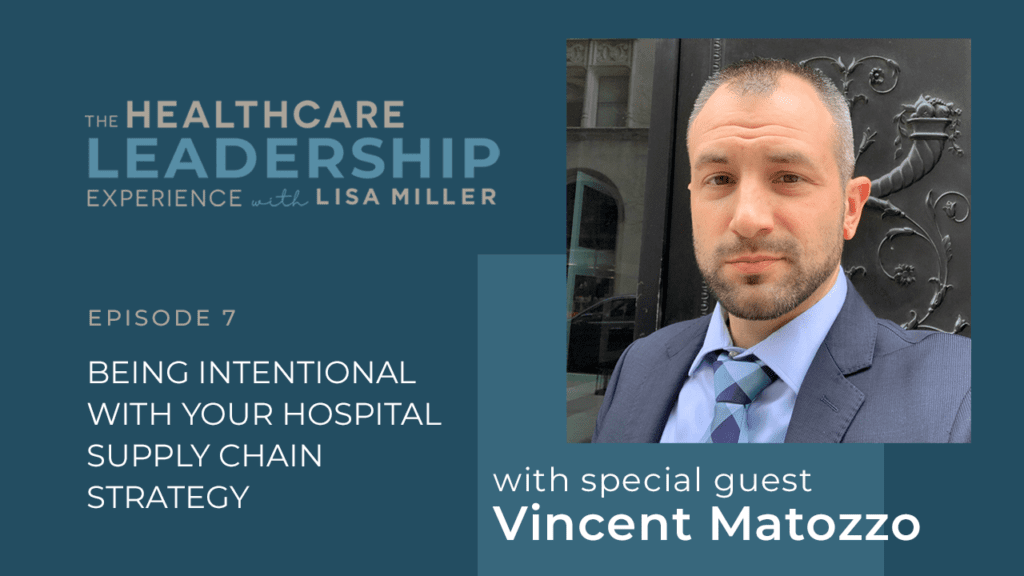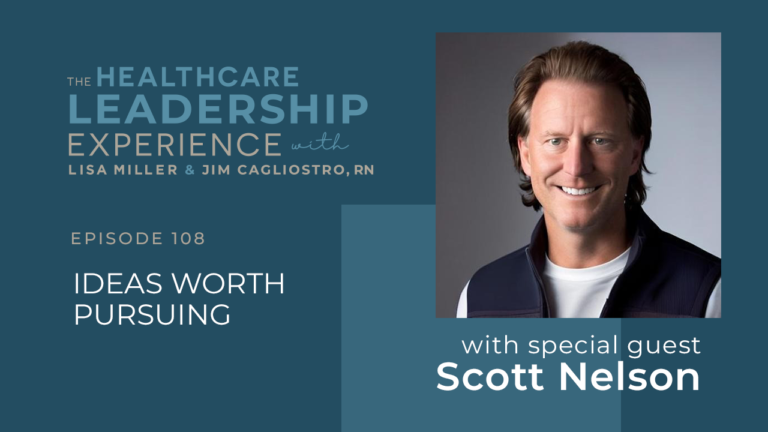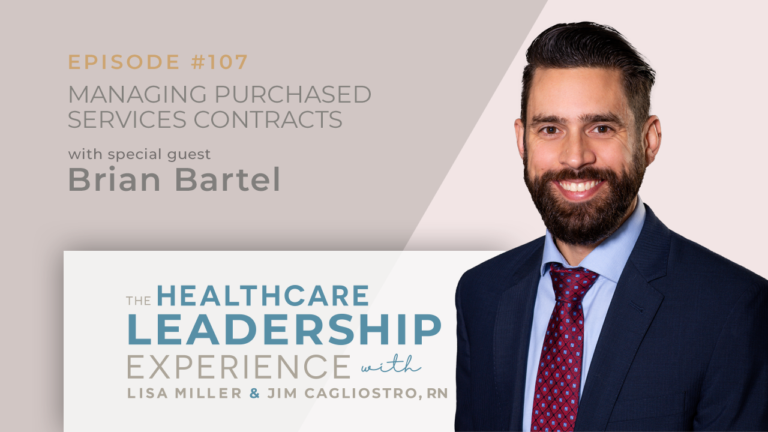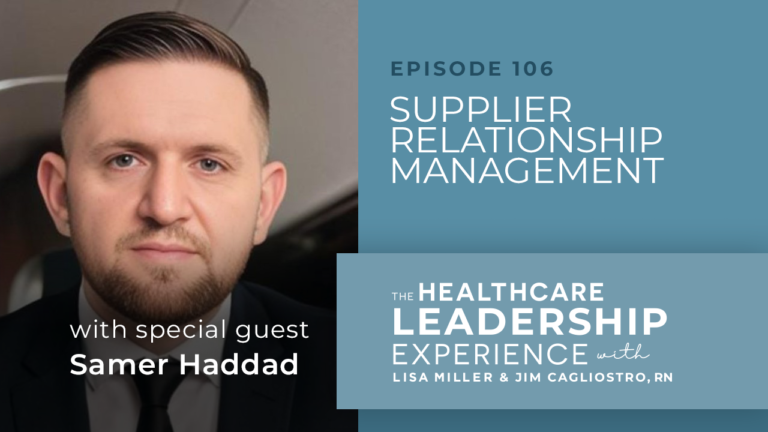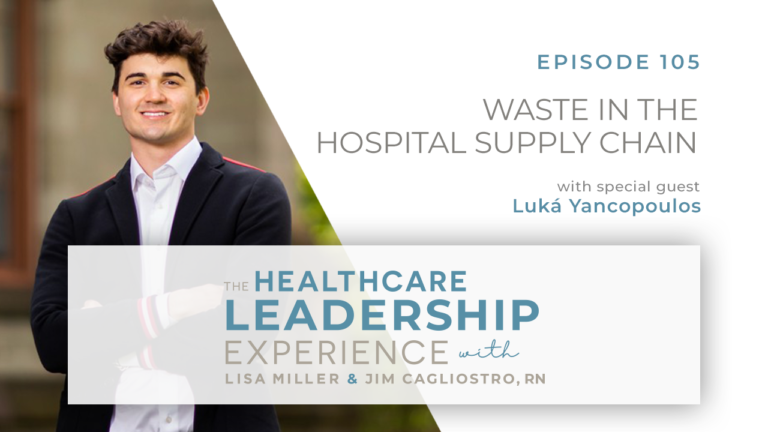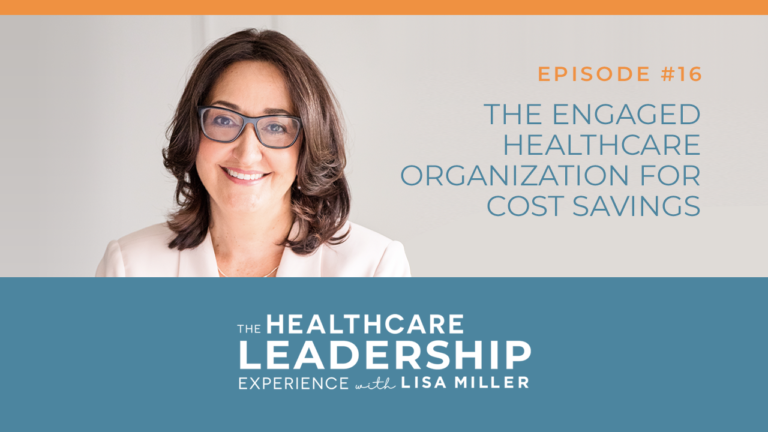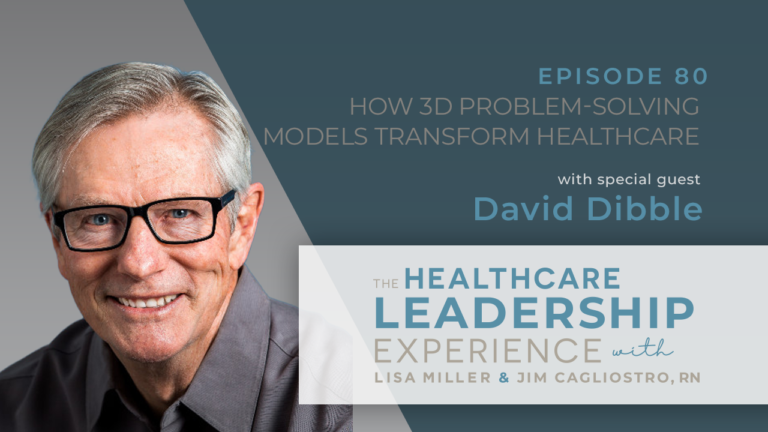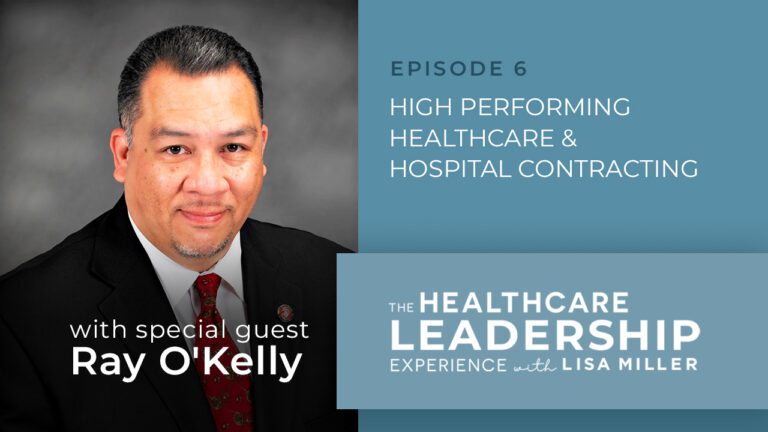In Episode 7 of The Healthcare Leadership Experience, Lisa is joined by Vincent Matozzo, Corporate Supply Chain & Strategic Sourcing Leader at Yale New Haven Health. Together, they explore the need to be intentional with your hospital supply chain strategy.
As Vincent observes: ‘’The ability to be intentional comes from a great foundational data analytics strategy.’’
Today’s episode is sponsored by Invoice ROI™, the only patented purchased services and indirect spend technology to manage, monitor and benchmark line item details.
In this episode you’ll hear:
- Why data analytics is mission-critical to the hospital supply chain, (and why siloed data doesn’t drive continuous improvement outcomes).
- The evolution of supply chain, from operating in silos to a supply network.
- The difference between Lean and Six Sigma principles. ‘’What gets measured gets done.’’
- How to manage supply chain strategic initiatives during a pandemic and why every health system must move out of category management, actively react to what’s happening in the marketplace and then deliver.
- The value of a supply chain peer group (and the advantage of vicariously learning the negative examples). ‘’We all owe it ourselves to change the seven most expensive words in healthcare …‘that’s the way we’ve always done it.’ ‘’
- The importance of supply chain to the C Suite – and why the time is now for the supply chain to fill the margin gaps and support the financial sustainability of a hospital or health system.
- Why healthcare organizations need to adopt foundational approaches to intentional project and program management. Hint: it’s about having and measuring the right tools and impact to continuously improve.
- The need for a strong performance improvement team and project management group in every health system. ‘’Organizations are great at building sandcastles … but come high tide and the next emergency… we do exactly the same thing, starting from the ground up.’’
CLICK HERE TO DOWNLOAD THE PDF TRANSCRIPT
Connect with Vincent:
📱 https://www.linkedin.com/in/vincent-matozzo-53b8984a/
Connect with Lisa:
🖥 https://viehealthcare.com
📱https://www.linkedin.com/in/lisamiller/
Check out this episodes sponsor:
🖥 https://viehealthcare.com/category/invoice-roi/
CLICK HERE TO OPEN THE FULL TRANSCRIPT
Lisa Miller (00:05):
Well, Vin, I want to thank you for being on the show today, the Healthcare Leadership Experience Podcast. And I know that you have a very, very busy schedule, so we’re going to get right to some questions. One of the aspects that I really enjoy talking with you about is data analytics. Can you share with the listeners, your insights and your thought leadership about data analytics and why it’s mission critical to the healthcare supply chain?
Vin (00:36):
Yeah. Without, I think, using any of the adages and things that are done in the past, data analytics really ends up being the fuel for where I think supply chain wants to be and wants to go. And if you look at, typically, what happens in healthcare, you’re only as good as the fuel or the water — or whatever analogy you want to be able to use. But the reality is, that’s what’s going to help you go from a foundational and transactional to strategic — and then really be able to orchestrate. Whether that’s your MMIS and your data analytic strategy, how you’re parceling, attributing, classifying, categorizing, and then creating your plans associated with that — all the way down to how you manage your storerooms, your velocity, your inventory turns. And it’s connecting, typically, that siloed data that’s happened in healthcare for so long that really had not driven any continuous improvement outcomes.
Vin (01:28):
And if you look at Lean and Six Sigma principles, and they’re actually two different things. Many people will say Lean Six Sigma, right? But Lean is really reducing the fat, and Six Sigma is reducing the variation in a process. What gets measured really at the end of the day, gets done — whether that’s unit of measure, part exception, price exception, match exception, rejections, all the way down to dirty preference cards. You can’t do much, if you’re anecdotally solving problems. So, the ability, really, to be pragmatic and to be intentional comes from a great foundational data analytics strategy.
Vin (02:02):
What did I pay? Where did it go? How did I procure it? How do they optimize the channel? And how did that affect my margin or my customer, keep my patients safe, keep my staff protected, fill the hands that heal? and really be able to pivot accordingly.
Lisa Miller (02:20):
Thank you. That’s great. Because we are hearing more about data analytics and you’re right, there’s just not to just the adages, but what’s the practical uses for data analytics, and you and I have had some conversations and I love what you’re doing. Do you want to share maybe a specific program or data analytics area that you found useful? Again, this is just really to give our audience some insights and maybe something that they could take back. And that’s really the goal of the show is that, we can give people some ideas to say, “Okay, maybe let’s try that at my hospital.” And maybe there’s a program or initiative that you worked on, you could share with us.
Vin (02:57):
Yeah, sure. So I think specifically, as things really relate to data analytics, categorically, it’s important to really start with what you’re going to achieve and what you’re going to do. So, one of the things, whether it was sourcing the COVID categories and what we wanted to create an approved substitute for, or going after additional cost savings — the mission really started with getting a category together, and then taking that category lead and the VAN or the value analysis nurse, or the subject matter expert to be intentional. So, how do you protect the shop? Well, you need to project the burn rate. How do you project the burn rate? Well, you understand what you bought, why you bought it and how you used it last year. And then you start to really optimize the channel based on what you know, and what happened in the market.
Vin (03:40):
So, in our COVID work cells, whether it was personal protective equipment, FFRs the full face respirators and whatnot, or the critical supplies to administer vaccines, IV tubing, anything above — it really came down to the categorization. And we had to be intentional, because what we found was a lot of things that we assumed were a category, or were an opportunity, were either a construct for a contract — where someone else’s view on what they thought our data was supposed to tell them, or ultimately, really didn’t protect the caregiver when it came down to the form, fit, and function and what we wanted to do. And then, similarly, in those parallels, when we looked at how we were buying and what we bought it, we noticed that the same rigor we had on the clinical side for the categorization really didn’t exist in a lot of the purchase services categories.
Vin (04:29):
So what does that mean? It means visualizing to your IT executive that you spent more on Microsoft service licenses than you did on your EMR application, for the year in general. And once you’re intentional about that, and you give that awareness, it’s about being able to deconstruct that and create a plan to really take apart those categories, segment your costs, and to purchase services into operational expenses, into things that are going to drive the outcome versus the nice to haves as an organization expanded or grew that now necessarily aren’t in the budget, or weren’t really being properly policed.
Lisa Miller (05:04):
Right. Thank you. Wow, this is a great discussion. I have another just a discussion about initiatives, you mentioned COVID, and so COVID hit us, and we had… I worked with several hospitals who had some great initiatives for 2020, and then COVID siderailed… It’s everywhere, I’m not talking about a specific one. It was just… I think you just did a new distribution center, if I’m correctly remembering. So, it’s interesting, how do you get through those initiatives that we need to still kind of move through and achieve those outcomes, I believe, like your distribution center, but still deal with this huge undertaking, especially with your large system, with COVID? How were you able to do all that? It’s a lot. Sometimes we need to pause and sometimes you need to plow through, right?
Vin (06:02):
Yeah. No, absolutely. I think it’s about being intentional in your strategy. And for a long time, supply chain really kind of operated in silos, and it’s really not a supply chain anymore, it’s a supply network. Because you’re looking at all the tier one, tier two suppliers that support your actual manufacturers or suppliers, you’re understanding the logistics, the trucking shortages, the cargo jams at the incoming ports of entry, longshore men’s strikes, weather events, anything that really is driving inconsistency, national recalls. Many people don’t know prior to the pandemic, there was a national gown recall out there from one of the large manufacturers that actually affected us.
Vin (06:41):
So come off the tail end of an IV shortage solution into a bioburden and your sterile procedural and surgical gowns, enter into a pandemic. And in the middle of that, we really took pause and said, we changed our primary Med-Surg distributor, really to be able to augment for a vertically integrated strategy. And because we knew we had to go further and faster together. We then also opened a regional operation center recognizing the model. It was always the plan, but we pivoted early, and actually I kind of call it our pandemic dumping ground, because it was not a traditional warehouse in any sense, there actually wasn’t even wracking — but we were able to pivot and recognize the asset for what it was able to do.
Vin (07:24):
And that was able to give us both purchasing power and opportunity to stage kit and deliver a conventional use item that might not have been what we would have been used to, but to be intentional, to make it auto sub, to fill to the best opportunity we could in our just-in-time delivery, because the health system was really too large to be successful on a one-off. And then really coordinating effectively with our partners, for what was actively able to be sourced in the market in whatever channel we can get it, driving it into the distribution methodology that made sense, and working with our value analysis team to educate the clinicians on what was coming down the pike and what was to be appropriately used.
Vin (08:04):
And as you really look at that, the sum of all of those parts were important. A conventional and a strategic use strategy, being able to pivot and modify your distribution channel to something that wasn’t available a couple of months previously — and then really orchestrating and connecting that information into the burn rate and scaling, based on what we saw happening in the marketplace or with our patient census, and really being able to act to that appropriately. But it did, it took cross-functional collaboration between each one of those teams, whether you’re centralized, decentralized, whatever model your healthcare system or your control tower really works from, you move out of that category management very quickly, and to actively reacting to what’s happening in the marketplace, and then you have to deliver it.
Vin (08:51):
So, it was pretty interesting to pivot — probably not the best time to convert primary distribution and open a regional DC — but when the approach was right, when things we saw that were driving value towards the outcome and the team was getting excited about how the opportunities would change their roles, and it got people thinking on really pivoting now and thriving later. We have to be able to serve the mission today and we can get it right and continuously improve. But we could also change our thinking, because we wouldn’t have necessarily gone to an international direct-sourcing agreement, import kit and just-in-time delivery from a warehouse ourselves. So it was kind of a unique experience. And there’s probably not too many people can put that on their resume in their career. So glad to be there and glad to be a part of the team.
Lisa Miller (09:36):
Yeah. It takes great leadership to make all that happen. So it’s a great team that you have. I have two last questions and one, I just wanted to… It just came to me because you’re a great mentor and you’re also a great collaborator — can you talk about how important it is to have peers? To really have these conversations with peers and there may be, in some cases, we might have competition, but the reality is, we’re serving patients and families. And so can you just talk a little bit about how important it is for us as a peer group supply chain to be working with one another and just collaborating, best practices? Can you share a little bit about it?
Vin (10:22):
Absolutely. And whether it’s a GPO, an IDN, a professional affinity group, things that are out there like are ARM or CPEN I think it’s always interesting to take unique perspective and the sum of all the parts. So diversity is more than just a fun buzzword that happens in cultural or political issues, it really is diversification of thought. And you’ll get a much better approach by bringing smart individuals around the table and talking through a problem.
Vin (10:50):
A lot of times what you find is you’re so fixated on resolving the problems, that it takes Herculean effort and things you wouldn’t normally do from continuous improvement. So, working in that peer group, it gives you an opportunity to resolve the issues that shouldn’t exist and focus on the problems, because someone will offer a unique perspective, a different approach, a way to categorize or frame a problem, in necessarily an opportunity that a certain subset of individuals — whether it’s geography or GPO or prior experience or even industry, our industry is kind of like the nature and nurture of your career.
Vin (11:27):
You come from what you know, and outside industries, where you have demand planning and search engine optimization and forecasting capability and market intelligence, you come into healthcare and you’re like, “Oh, well, my current SKU isn’t available.” And it’s funny because the number of SKUs are smaller and there’s no McKinsey model or contract manufacturing play — but it takes an intentional inflection or a fresh set of eyes to really frame the problem differently. And sometimes that perspective is valuable. Sometimes it’s incrementally finding that causes you to challenge things. And sometimes it truly is a paradigm shift, of being able to truly recreate a view, visualize that data differently, and approach it from that group think tank kind of mentality. No one’s going to have all the right answers, and I think we all owe it to ourselves to change the most seven expensive words in healthcare, which was “that’s the way we’ve always done it.”
Vin (12:22):
And if nothing else, this pandemic, and this year really forced us to think that 2020, didn’t look anything like 2019 and was way further than 1999. Right?
Lisa Miller (12:33):
Mm-hmm (affirmative).
Vin (12:33):
And so if you think about the exciting connected nature that needs to be that connected enterprise and the internet of things, and in demand forecasting and in a market where even cyberbullies are out there with ransomware and those kinds of threats, we’re all in it together, sharing those best practices. You can move at a much more exponentially faster speed, and my personal favorite is vicariously learn the negative examples.
Vin (13:00):
I’ve kind of growing up in supply chain and a couple of different industries, there’ve been quite a great few leaders out there that have really set the stage for some impressive things. And some have made some pretty interesting, I wouldn’t call them missed assumptions or assertions, but have learned those lessons in a hard way. And I think it’s that vicarious learning, when you’re taking on a demand program, or launching a value analysis team, or looking at how to forecast and categorize your data differently, or even just how you approach a category like direct and indirect spend, that unique perspective being shared across verticals, across GPS is going to lead to a better net future.
Vin (13:42):
So I think it’s absolutely quintessential, and if you think you’re doing something right, go ask five of you friends, and sometimes, as long as they’re pretty candid with their feedback, it’s usually a pretty good experience.
Lisa Miller (13:53):
Yeah. I love your answer, because you took it out really broader, and it’s so important that we look at the industry as a whole, and the group think is so important, in looking at our challenges from different perspectives, that’s a great, thorough kind of perspective. Thank you. Thank you. Vincent.
Lisa Miller (14:12):
Last question is, we’ve seen supply chain… We often hear from the basement, but I certainly don’t think we’re in the basement anymore, but we often hear supply chain is moving its way to the C-suite, but I’ve seen that progression, particularly over the last several years. But I actually have always said, and I think now more than ever, supply chain probably has one of the greatest opportunities to have a financial and margin impact to a hospital and health system. And just as we… In this discussion, I just want to get your feedback on what you’re seeing and how important your C-suite or ops is looking at supply chain to provide those margin… to fill those margin gaps and to really support the financial sustainability for the hospital? I’m sure you’re seeing that they’re really relying on supply chain now more than ever, right?
Vin (15:12):
Yeah. It was interesting. We actually, in the middle of our pandemic, were able to not only meet, but exceed our supply chain savings target for the year. And it was really interesting, because if you unpack what the supply chain or vendor management office will look like in 2025, or the next five years — it comes down to really that relationship management. And to your point, that basement/boiler room, down the supply chain hallway, where we used to carbon copy papers in the basement to having a Chief Procurement Officer. Someone that sits at the proverbial table, and driving strategy and demand from the relationship management, both with the clinicians and the outcome and the suppliers and the partners, even community health and community equity partnerships driven from the supply chain office, that relationship management, the performance and the financial management.
Vin (16:02):
Not just of our contracts and our suppliers, but anyone can author a paper, a great contract — but are you actually monitoring, measuring, and implementing that performance? What drives you? What keeps you up at night? The contract management obviously is always a function, near and dear to my heart, and the strategic sourcing piece. And you have things like the financial impact management — but compliance and governance are really that last thing. And it’s creating that structure to bring the data, to visualize and architect the strategy. What did we buy? How did we cost it? What are we getting out of our EMR? How do those demand signals work? How did we improve and enable our better buying, our better fulfillment versus distribution? And all those concepts. And really you look at it like the Chief Analytics Officers that used to be decision support in the ’90s, they’re all now driven.
Vin (16:55):
Everyone’s looking for business intelligence reporting, that business intelligence platform, that Tableau, that first way to render and connect those silos. And I think there really isn’t a better partner in a healthcare or in an organization really more centrally situated than supply chain to do that. You have the proverbial ammunition and the weapon, because the data is there in terms of usage, it’s there in terms of what you paid. And as long as you can craft a narrative in a way where you can articulate a strategy and manage the inputs and outputs. It’s not about getting it right out the gate — it’s about having and measuring the right tools, the right impact to proactively improve, to continuously improve and to be able to do that. I don’t know many other organizations that can come in and advise vice-presidents and overseers of service lines and cost centers, not only on their costs, but on their improvement, on their outcomes.
Vin (17:48):
And then really integrate that with a strong performance improvement team and project management group to articulate, to collaborate, and to measure a truly equitable change. One of the best analogies I use all the time here is, organizations are great at building sandcastles. So no matter how ornate or how beautiful or eclectic that sandcastle is, come high tide, the next problem, the next emergency, and the next fire drill, we do exactly the same thing starting from the ground up. And so we really can’t build sandcastles. We have to take foundational approaches to intentional project and program management, lessons learned, codified and control policies and procedures that are driven by metrics that the C-suite really cares about. Improving your margin, looking at your outcomes, the patient satisfaction scores, and then working backwards from those end-users with the proverbial cost data.
Vin (18:44):
No one ever said, “Hey, let me see that spend report,” and correlated that to margin improvement or to a patient satisfaction score. So, I think that’s where the industry really had a lot to learn. And the pandemic, I think, was a very astute and unforgiving teacher. So hopefully, there’s a lot of organizations re-investing in what goes into supply chain. And it’s not just the guys that sit quietly in an order and process the pink slips and carbon copies all day.
Lisa Miller (19:13):
Yeah. You gave a really nice end-to-end view of how important supply chain is to the organization, to the C-suite, and it really covers many different aspects and even to patient satisfaction. Vincent, I just want to thank you for being on the show today. I have a feeling that people are going to want to reach out to you. I have this hunch that they’re going to want to… other hospitals or health systems may want to reach out and maybe just talk for a couple of minutes. So is there so where they can reach out to you or they probably know you through LinkedIn or they can connect with you somehow. Vin is there…?
Vin (19:53):
Yeah. Definitely, obviously, the views and opinions today were my own. Obviously, I’ve had the privilege of working and leading in some pretty prestigious institutions, but Vin Matozzo, M-A-T-O-Z-Z-O on LinkedIn. More than happy to connect with anybody, in quite a few of the industry and peer groups and have been around in a few conferences. So more than happy to look up, always willing to share and compare notes, and steel sharpens steel. So very happy to collaborate and have some open dialogue about challenges or opportunities or concerns. So would welcome that.
Vin (20:28):
And Lisa, you and your team have always been fantastic and thought-evoking, as it relates to visualizing. A lot of those opportunities using a pretty pragmatic data approach to aggregate data sets differently. And then to be very intentional about some of the lessons learned and to apply that. So, groups like yours that are going to take some of those best practices, combine that with technology, and then really open this collaborative type of forum to others to really poke holes or to help evolve. I think it’s kind of the fastest way to get there, so I really appreciate the forum and the opportunity to do these kinds of things. So kudos to you and the team as well.
Lisa Miller (21:01):
Thank you.
Lisa Miller (21:05):
Well, thank you. Thank you very much, Vincent. We’ll talk soon.
Vin (21:09):
Take care.
